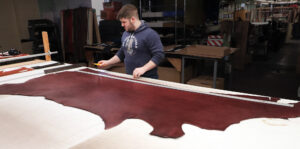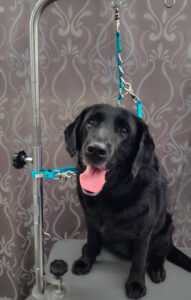
Training Your Puppy Before He Trains You
February 7, 2017
Our puppy is now three months old and tonight we start a Basic Puppy Class. I can’t wait! We’ve made great strides as far as house training is concerned. If an accident happens we know that it’s our fault for not getting our puppy out quick enough. Everyone has learned that he doesn’t get any freedom in the house and we’ve also learned to read his body language signals. The problem that we’re having now is that we never get any downtime. The puppy is on the move constantly. During the week, everyone is up and off to school or work by 7am. We start arriving home around 4pm. From the second the puppy is let out of his crate he’s non-stop. He jumps on the kids and zooms around the house like his butt’s on fire. One of his favorite games is “chase the cats.” Of course, they torment him and then the chase is on. The other chase game that he loves to play is “look what I’ve got.” He’ll grab a sneaker or the remote control and as soon as someone notices that he has something he shouldn’t have, he turns and runs off. When we do finally catch up to him he won’t drop the object either.
All the issues above are very typical. The bottom line is your dog is going to do what works for him. Many times, we reward the very behaviors that are not desired. Also, remember that dogs are very good at training humans to do things their way. Let’s look at these issues from your dog’s perspective.
- Jumping and putting paws on humans. Many times, we teach puppies to jump on us. We enter a room, bend over and say “Fido… how are you today?” while patting our legs. Fido comes running over and puts his paws up on us and what do we do? Reward it by petting him. Fido figures out very quickly that it’s rewarding to approach a person and put his feet up. Even if someone says “NO, Fido—off!” while pushing Fido down with their hands… it’s still rewarding an undesired behavior. Fido now thinks you’re playing because you’re pushing with your hands. To him this is an invitation to play. To extinguish jumping we need to help Fido realize that it’s more rewarding to keep his feet down. Be proactive by rewarding four-on-the-floor. Every time your dog comes over to you and the feet are on the floor, praise him. When he does put his feet on you ignore him by turning and walking away. It also helps to keep a leash on your dog and step on it to prevent jumping. Teaching your dog that four-on-the-floor is more rewarding than jumping can take a lot of practice, patience, and time.
- The game of chase. First let’s address chasing the cats. What I tell my clients is, “Don’t let your dog practice things that you don’t want him to get better at.” Chasing the cats was a problem that I had with Walker, my Springer Spaniel, when he was a puppy. One thing that helped was having him on a leash in the house. As soon as I saw that he was getting interested in the cats, I would calmly walk over to him, step on the leash, and tell him to settle down. As soon as he settled down, I would reward him. After a period of time (I think it took about four months) he finally learned that chasing the cats was not going to be allowed.
- Now the game of “look what I’ve got.” Remember that dogs are very good at training humans to play their games. So, if they figure out that by grabbing certain items you’ll chase them, then they will get better at that game. First of all, puppy-proof your home. Set your pup up for success by putting items up or in closets where he can’t get to them. Next, do not chase him. When he grabs an object that he shouldn’t have try exchanging it for something that is of higher or equal value. Having a leash on him will also help prevent chasing.
- Exercise is key. I often say that if people provided their puppies and dogs with enough physical and mental exercise, I would be out of a job. Exercise helps with every dog issue. This is probably your biggest challenge. Matching a breed’s exercise requirements with your lifestyle helps. Not every breed of dog is going to be the best match. Too often this is an afterthought. If your puppy or dog’s energy is not burned off in a positive way, many times they will look for ways to burn it themselves by digging, chewing, barking, jumping, etc. Dogs love to walk, run, play fetch, swim, do agility, treadmill walk, etc. Adding mental stimulation will also help burn energy. An easy way to add mental stimulation is to make your puppy or dog work for his food. Instead of feeding your puppy or dog out of a bowl, consider putting it in a treat dispensing device such as Kong Wobblers, Buster Cubes, or Kibble Nibbles. This is also a good way to slow down a fast eater.


